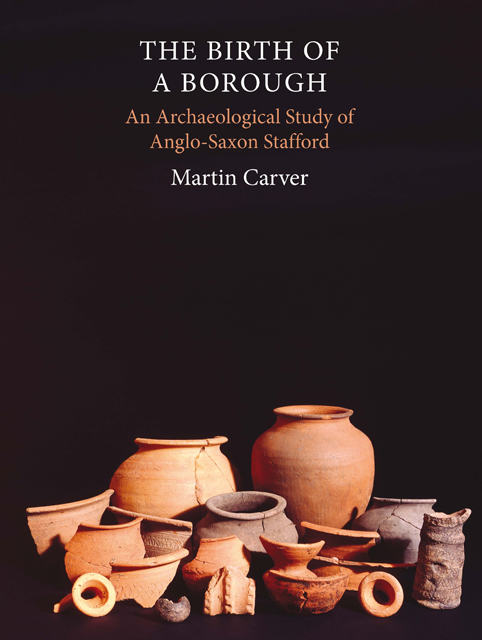Book contents
- Frontmatter
- Contents
- List of Illustrations
- Preface
- Acknowledgements
- Abbreviations
- 1 Questions
- 2 Digging up Stafford: Evaluation and Design
- 3 Seven Windows on Early Stafford: The Principal Investigations
- 4 Æthelflæd’s Town
- 5 Aftermath: Norman and Medieval Stafford
- 6 Anglo-Saxon Stafford in Context
- Digest A1 Archaeological Interventions at Stafford to 1988
- Digest A2 Dendrochronological and Radiocarbon Dates
- Digest A3 Pottery Seriation
- Digest A4 Key to Pottery Illustrations
- Digest A5 Excavated Structures
- Digest A6 Contents of the Stafford Online Archive: http://ads.ahds.ac.uk/catalogue/archive/stafford_eh_2009
- Bibliography
- Index
- Frontmatter
- Contents
- List of Illustrations
- Preface
- Acknowledgements
- Abbreviations
- 1 Questions
- 2 Digging up Stafford: Evaluation and Design
- 3 Seven Windows on Early Stafford: The Principal Investigations
- 4 Æthelflæd’s Town
- 5 Aftermath: Norman and Medieval Stafford
- 6 Anglo-Saxon Stafford in Context
- Digest A1 Archaeological Interventions at Stafford to 1988
- Digest A2 Dendrochronological and Radiocarbon Dates
- Digest A3 Pottery Seriation
- Digest A4 Key to Pottery Illustrations
- Digest A5 Excavated Structures
- Digest A6 Contents of the Stafford Online Archive: http://ads.ahds.ac.uk/catalogue/archive/stafford_eh_2009
- Bibliography
- Index
Summary
Before the burh
The sand and gravel peninsula, which was to provide the arena for Stafford town, formed part of a prehistoric landscape, although not one that is yet well known (Fig. 4.1). The King's Pool on Stafford's north-eastern shoulder is a deep channel which trapped up to 21 metres of organic deposits, commencing in 13000 BP at the end of the last ice age. The subsequent pollen record shows the expected sequence of afforestation and elm decline, but the major episode of tree clearance is here dated to the mid Iron Age between 800 and 600 BC. From then on, cereal cultivation appears to be active, with later peaks possible in the seventh century and marked in the tenth and eleventh (see Chapter 3, pp. 53–55).
Iron Age
Excavations in the town and casual finds outside it have produced a handful of flints, one Mesolithic, the remainder Neolithic in date, and an antler pick from the pool. This may be seen as part of a general spread of prehistoric ‘dark matter’ without so far indicating a focus. But by the Iron Age the peninsula is largely surrounded by open water and there is a settlement at its centre. An Iron Age settlement is not easy to find under a modern town, but in this case we have enough evidence to identify one in the form of four-post granaries at the St Mary's Grove site (Fig. 4.2). There were two four-posters and part of a third (Fig. 4.3). The post-holes were defined against natural sand subsoil and contained charred matter. Samples examined proved to be 90% wood, but grains of emmer and spelt, with small amounts of bread wheat, rye and barley were also present. A radiocarbon date on wood from S19 came in at 520–190 cal. BC. No artefacts were recovered from the post‑hole fills, but the interface between 2240 (the natural subsoil) and the soil 2238/9, which sealed the four-posters, produced two fragments of possible Iron Age pottery. An area of subsoil 15 × 20 metres was cleaned at recovery level D but no other features were identified which could belong to this phase.
- Type
- Chapter
- Information
- The Birth of a BoroughAn Archaeological Study of Anglo-Saxon Stafford, pp. 58 - 101Publisher: Boydell & BrewerPrint publication year: 2010



